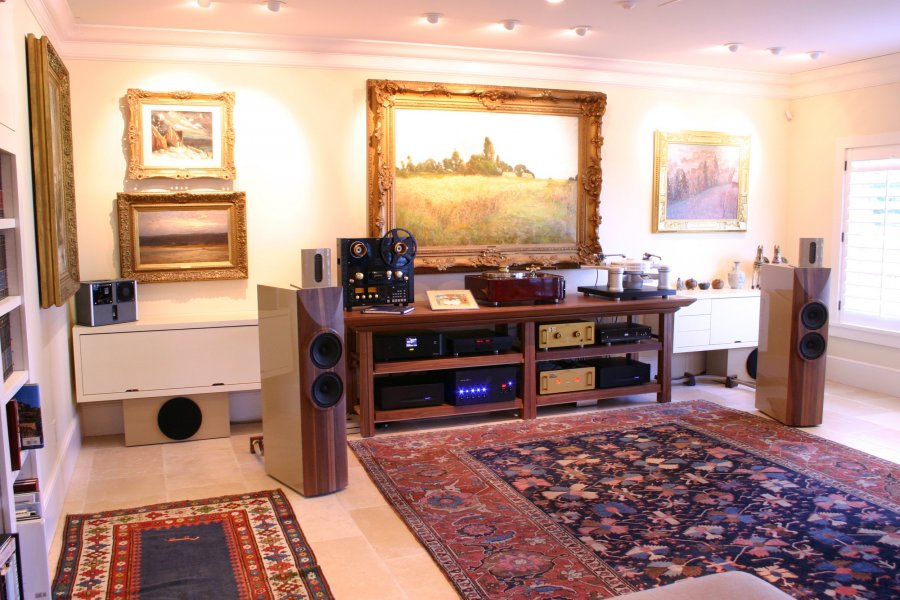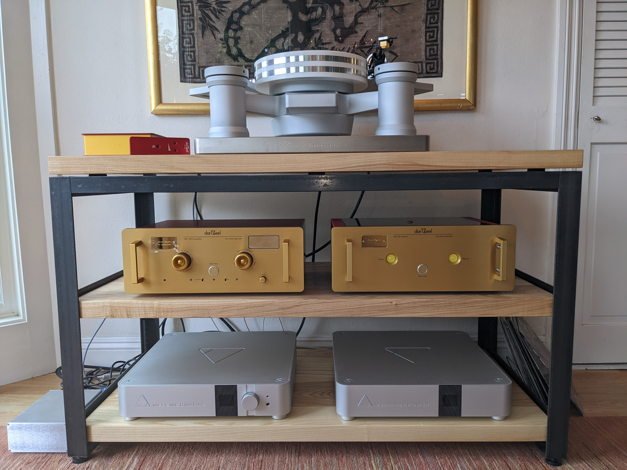In his forum REG mentioned the concept of "anechoic stereo" when he was talking about the
Gradient Experiment (scroll down to "All loudspeakers sound equally well" heading). As REG noted,
in an anechoic room, the Gradient experiment found that all that really mattered for the speaker to be seemingly transparent was flat response. However,
in an ordinary listening room, the speaker must be flat plus highly directional in order to seem transparent. REG noted the Gradient 1.3 came out of this experiment and that the 1.3 was designed to have minimal room interaction, producing something like "anechoic stereo" even in a regular listening room. REG mentioned he likes anechoic stereo, even if others don't. He also said that few recordings are actually recorded in such a way as to be meant to be listened to in rooms which do not add their own reflections or bass support.
I had said in an earlier message that speakers should "ignore the room." I was picking up on the "anechoic stereo" idea that the speakers should be designed to sound in a listening room as closely as possible to the way they sound in an anechoic chamber. A good part of this is to reduce audible reflections from room surfaces in the mid and high frequencies and doing what you can to smooth bass response. I agree with REG that I like this type of sound even if others may not.
Beside the Gradient 1.3 and subsequent Gradient designs (most of which I've owned in the past), a full-range flat-panel dipole speaker with very narrow dispersion would also seem to fill the bill of ignoring the listening room. Such a dipole panel would minimize early reflections off side walls, floor, and ceiling as long as the panel is vertical and aimed at the listener. It would also interact less with room modes since less sound is produced toward the top and bottom and lateral edges of the panel. The mid and high frequency room surface reflections from the back wave can be easily absorbed with a few pieces of foam on the walls behind the speakers since the back wave dispersion, like the front wave, is very narrow.
Now, I've been down the dipole bass road enough times (e.g., Carver Amazing Platinum Mk IV, Legacy Whisper, Linkwitz Orion, Gradient Revolution + added dipole sub towers) to know that getting high-level low bass and punchy bass with dipole woofers is very difficult indeed. Boxed cones just work and sound better down deep. So, for better bass, you add a woofer to the flat dipole panel and keep the crossover to it as low and steep in slope as possible, and apply EQ to smooth the bass. You end up with something like the Sanders 10e, the theory behind which REG so ably explained in 2017 in
his Sanders 10e review.
I probably should have purchased the Sanders 10e a few years ago, but I had a probably atypical experience with the earlier 10c in a different room a decade ago; see my first couple of posts in this thread. It has taken me a while to work back my way back to the latest version of the Sanders 10 speakers.
In the interim I've reconciled myself to the idea that, with a dedicated listening room like mine and with me usually the only listener in that room, a speaker only has to sound great in the sweet spot. Thus, I no longer care if the highs are rolled off elsewhere in the room if the sweet spot can be this amazingly sweet.
And, if you want more highs elsewhere in the room, just undamp the back wave to taste. The sweet spot will remain almost as sweet, at least in my current small room listening to them from close up--58 inches panel to ear. The Sanders 10e sounds great in my small room even with no foam padding absorbing the back wave. With the Sanders speakers--unlike with all other speakers I've had in this space--my small listening room's own second-venue reverb is only really audible on sounds I know should sound non-reverberant, such as a radio announcer's voice. The D&D 8c was the best I'd previously heard in this room in that respect, but the Sanders seemingly are quite a bit better yet in this respect. They really need no foam padding at all even in my small room unless, like me, you really don't ever want your small reverberant listening space to announce its presence.
Actually, outside the room a bit down the hall the highs are not so rolled off, fairly similar to what I heard from the Dutch & Dutch 8c from the same position. It turns out that even with the Sanders' extremely narrow high frequency dispersion the sound still bounces off the diffusive surfaces behind the listening seat, out the open door, and down the hall. What I hear from my work desk a few feet down the hall is pretty well balanced for background listening while working. I wouldn't want super fidelity in my work space anyway since that would be too distracting.
And that's why I've concluded for now that the best one can do in speaker design is for the speakers to ignore the listening room to the maximum extent possible (helped along in this goal at the listening end by set up and room treatment) and that recordings meant to sound right that way will sound really right and the rest will just have to fall as they may.
As it turns out, with the Sanders in my room, "fall as they may" is usually at least as good sounding as this vast majority of recordings have sounded on any other speakers I've owned or heard. By "good" I mean low apparent coloration in the direct sound (which, with the extremely directional Sanders, is most of what you hear), extreme clarity, no apparent distortion on either transients or tones, instantaneous unrestrained large scale dynamic shifts, high SPL capability full range but sounding unusually satisfying at lower volumes, vanishingly low irritation from early reflections, and sound which is interesting, revealing, entertaining, and usually enthralling.
My recent forays into high-end headphones have also convinced me that there is nothing like a fine electrostatic headphone driver (e.g., my Stax SR 009S) for low distortion and clarity of sound without overbearing brightness or etch. And, while the stereo imaging and staging presented by unprocessed stereo headphones is not nearly as pleasing or natural as that from stereo speakers, totally removing the listening room from the equation yields the countervailing benefits of lack of early-reflection-induced distortions/grit/edginess and extreme stability of imaging and staging. Thus, moving toward speakers which interact less with the room seems a good move.
Ideally, I want speakers which combine the lack of room effects and clarity the best electrostatic headphone listening provides with the pleasingly natural "out there" sonic presentation of speaker listening.
And that is pretty much how the Sanders 10e sound from the sweet spot in my small room. They are uncanny. They have very natural tonality, are matchlessly clear and clean sounding, have fantastically precise imaging as well as very large open staging when the program material calls for it, and have whip-snap dynamics that must be heard to be believed. They give me "big" sound in all senses, even in my postage-stamp-sized listening room. Yes, from 58 inches away, they look like gigantic see-through headphones. But that's the goal: they sound like electrostatic headphones (no room effects, extreme clarity, and totally stable imaging and staging) but with the "out there" speaker presentation we audiophiles crave, plus the best envelopment/surround effects I've ever heard from a two-channel system on recordings where phase is manipulated. Even when phase is not purposely manipulated, the Sanders 10e yield a more enveloping sound than any other two-channel set-up I've heard because they better reproduce hall ambiance and manage to get that ambiance to appear well beyond the speakers--behind, wrapping around to the sides, and even a bit behind me.



